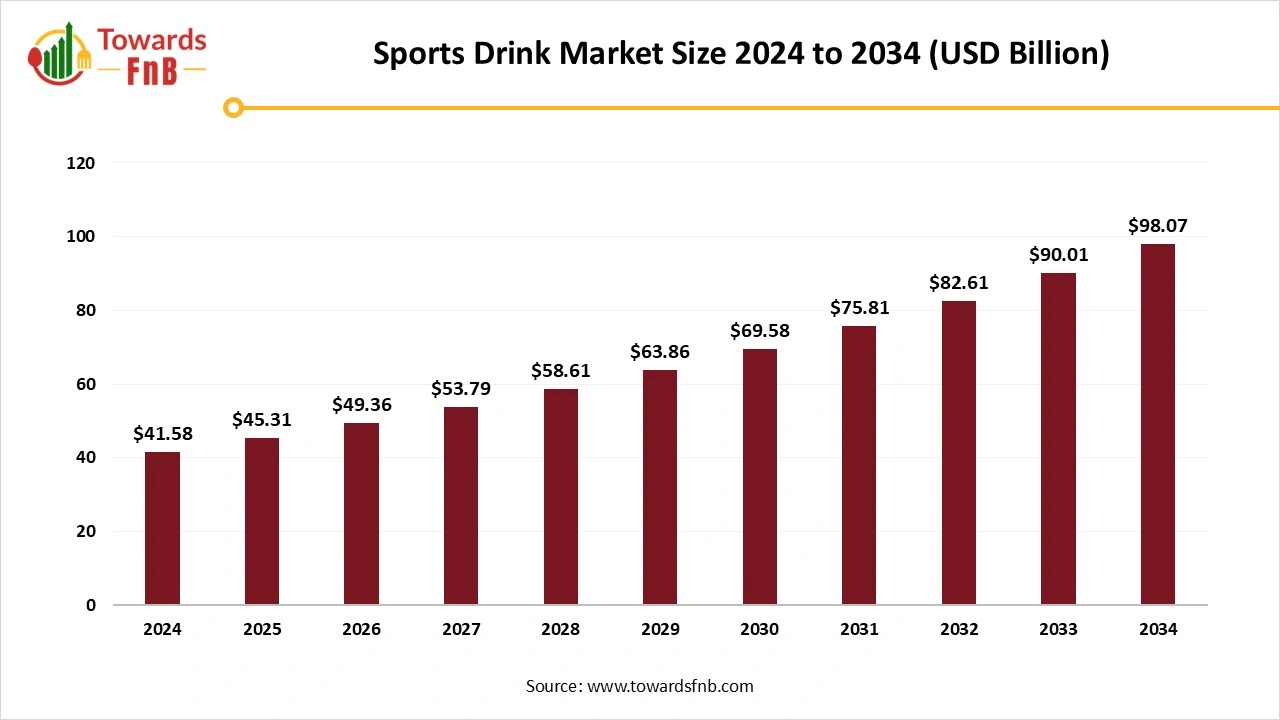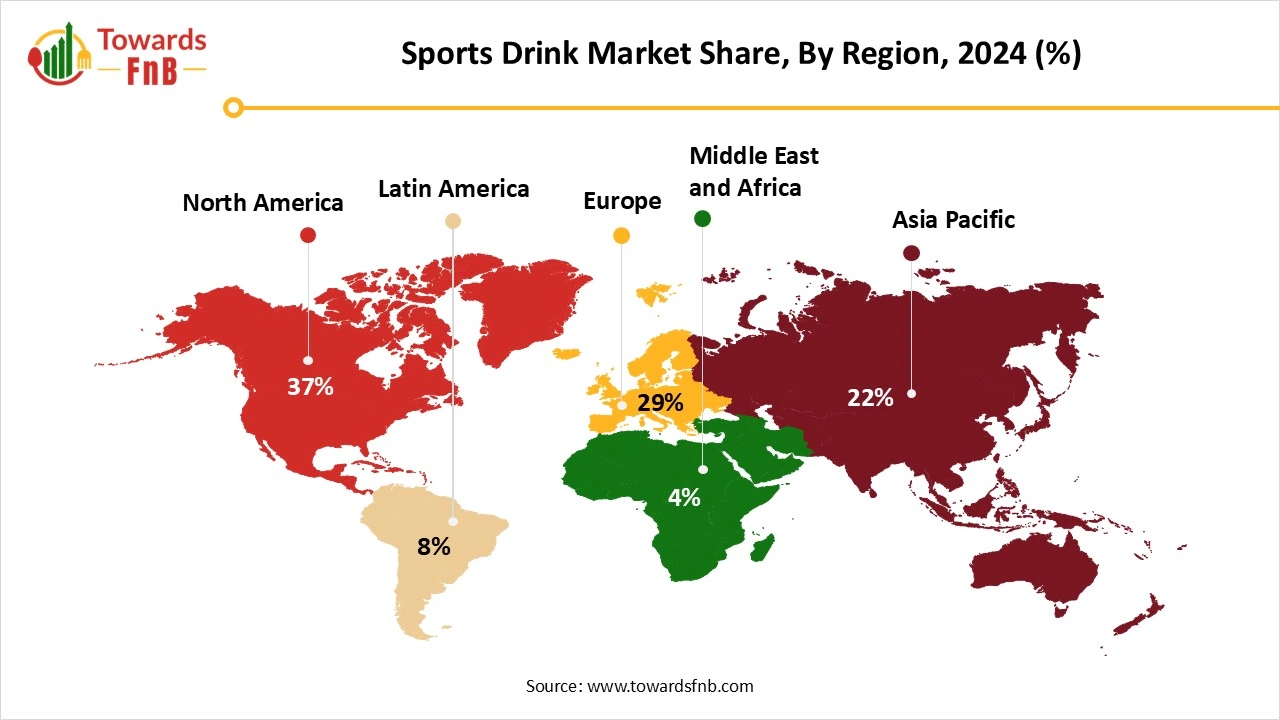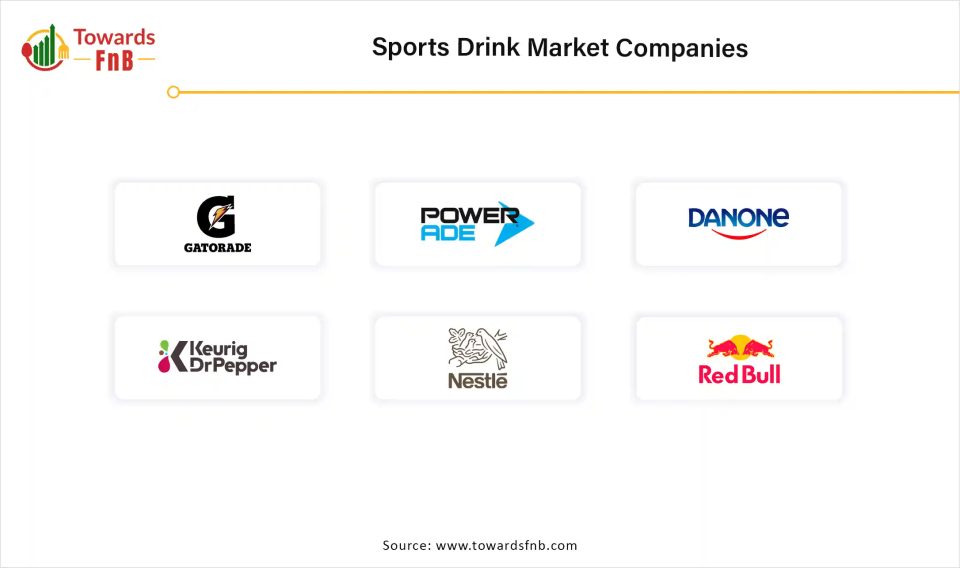December 2025
The global sports drink market size was valued at USD 41.58 billion in 2024 and is expected to grow steadily from USD 45.31 billion in 2025 to reach nearly USD 98.07 billion by 2034, with a CAGR of 8.96% during the forecast period from 2025 to 2034. The increasing popularity of sports drinks with natural sources and clean-label ingredients drives the growth of the market.

| Study Coverage | Details |
| Growth Rate from 2025 to 2034 | CAGR of 8.96% |
| Market Size in 2025 | USD 45.31 Billion |
| Market Size in 2026 | USD 49.36 Billion |
| Market Size by 2034 | USD 98.07 Billion |
| Largest Market | North America |
| Base Year | 2024 |
| Forecast Period | 2025 to 2034 |
| Regions Covered | North America, Europe, Asia-Pacific, Latin America, and Middle East & Africa |
The sports drink market refers to beverages that are made to help sports players and active individuals to replenish electrolytes, stay hydrated, and gives more energy during or after physical activity. These drinks typically contain a mix of water, carbohydrates (sugars), minerals like sodium and potassium, and sometimes vitamins or amino acids. The market encompasses isotonic, hypertonic, and hypotonic beverages designed to cater to different hydration and energy needs.
One of the major factors driving the growth of the market is the increasing consumer preference towards physical fitness. Leading to an increasing population trend towards fitness and physical-related activities, an increased willingness and buying power for healthier options is fueling global market growth. In addition, this healthy drink offers various benefits, including maintains the balance of electrolytes, replaces sweat electrolytes, and reducing the risk of electrolyte and dehydration in sports drinks, further enhancing the body. Furthermore, increasing awareness towards health and wellbeing offered by the various natural and clean-label products among consumers is further expected to drive the growth of the market.
The rising technological advancements are revolutionizing the market growth by creating sports drinks that are personalized, healthier, organic, and easier to access. Various technologies use plant-based electrolytes, low or zero sugar, and natural ingredients, making them more convenient and healthier for daily consumers. Smart packaging, such as eco-friendly materials, ready-to-mix sachets, and reusable bottles, is gaining popularity. In addition, various companies are integrating wearable tech and AI to offer sweat levels and hydration-based activities. These advanced factors are expected to revolutionize the growth of the sports drink market in the coming years.
One of the major restraining factors creating major challenges in the global market is the increasing demand for low-sugar drinks and the high cost of manufacturing sugar-free products. In rural areas, most of the people take the concept of taking sugar-free products and sweet products is still underdeveloped and uncommon. As the prevalence of heart disease, obesity, and diabetes is increasing rapidly across the globe, people are consuming sugar-free sports drinks, which are very costly and low-income people cannot afford to purchase, which may further create major challenges in the sports drink market.
How do North America Dominates the Sports Drink Market Revenue in 2024?
North America dominated the market revenue in 2024. The market growth in the region is attributed to the increasing demand for sports drinks, increasing demand for organic and natural products, changing dietary habits, and increasing popularity of sports beverages. The U.S. and Canada are dominating countries, driving the market growth in the region.

The U.S. dominated the sports drink market revenue in 2024, driven by the rising technological advancements in packaging and manufacturing, market revenue in 2024, driven by the rising technological advancements, increasing collaborations with sports clubs, increasing branding strategies, and ease of availability. The U.S. is the largest country in the consumption of various beverages. There are about 18·8 % consumed energy drinks, and 31·0 % of young adults consume sports drinks at least weekly in the U.S. Sports drink consumption is associated with higher sugar-sweetened fruit juice and soda intake among women and men, which increases the demand for sports drinks in the U.S.
Asia Pacific Sports Drink Market Trends
Asia Pacific is expected to grow fastest during the forecast period. The market growth in the region is driven by factors such as the increasing consumer preference towards organic and natural food consumption, increasing demand for sports beverages, increasing sufficient income levels, increasing consumer trend towards fitness and sports activities, and increasing consumer health awareness. China, India, Japan, and South Korea are the fastest growing countries, accelerating the market growth.
India is expected to grow fastest during the forecast period. Sports drinks have come to be appreciated by health enthusiasts, athletes, and regular exercising populations, as the trend for wellness & fitness surges in India. There are various well-known sports drinks manufacturers in India, such as the coca Cola Company, Thai Beverages PCL, PepsiCo, Gujarat Cooperative Milk Marketing Federation Limited, and Cipla Limited. With huge distribution channels and new product launches, these companies are in a premier position in this market.
How Isotonic Sports Drinks Segment Dominates the Sports Drink Market Revenue in 2024?
The isotonic sports drinks segment dominated the sports drink market revenue in 2024. The segment growth in the global market is attributed to the rising spending on fitness regimes, ease of accessibility, increasing partnerships and collaborations with individuals and teams, and increasing consumer ability to replace fluids via sweat. In addition, by maintaining energy levels and hydration, isotonic drinks can improve athletic performance and endurance. During physical exercise, carbohydrates are widely included in isotonic drinks, which gives a quick energy supply, further than expected to increase the demand for isotonic sports drinks in the global market.
The Hypotonic Sports Drinks Segment is Expected to Grow Fastest During the Forecast Period.
The segment growth in the market is fueled by the increasing consumer preference towards clean-label, sugar-free, and low-calorie products, increasing popularity in humid and hot regions, and increasing demand from athletes and casual fitness users. In addition, hypotonic sports drinks include lower concentrations of salts and sugars. Without adding so much energy, they are consumed quickly by the body and make them appropriate for rapid hydration, which is expected to drive segment growth.
Why does Bottles (PET/Glass) Segment Held the Largest Sports Drink Market Revenue in 2024?
The bottles (PET/Glass) segment dominated the sports drink market revenue in 2024. Sports drink bottles play an important role in keeping beverages healthy and safe. They are designed to protect drinks from light, moisture, and air. Good quality bottles keep the drinks nutritious and fresh for a longer period. Athletes and sports person can stay healthy and energetic by using natural and reusable bottles. In addition, reusable bottles are more eco-friendly than plastic bottles and are used for various beverages, especially for home use. Furthermore, various benefits of bottles, such as preventing contamination, maintaining freshness, preventing nutrient degradation, and keeping beverage aromas inside, are further expected to increase the demand for bottles in the global market.
The Pouches and Sachets Segment is Expected to Grow Fastest During the Forecast Period.
The segment growth in the market is attributed to the various benefits such as extending shelf life, sustainability, enhancing freshness, improving sports drink quality and safety, usability and convenience for athletics and everyday sports persons, increasing demand for resealable sports drinks packaging, brand differentiation, customization, and reducing the necessity of stock holding, which are further expected to drive segment growth.
What Factors Helps the Electrolyte-based Segment Grow in 2024?
The electrolyte-based segment held the largest market revenue in 2024. Electrolyte-based sports drinks deal with minerals that produce an electrical charge when mixed with water. They help to maintain the variety of the most important functions, such as hydration, muscle contraction, pH balance, and nerve signaling. Electrolyte-based drinks help people or athletics to rehydrate their bodies after playing games or intense exercise. In addition, various benefits of electrolyte-based drinks such as support hydration, prevent cramping, support heart health, support healthy blood pressure levels, and support nerve function, which is further expected to fuel the segment growth.
The Natural and Plant-Based Segment is Expected to Grow Fastest During the Forecast Period.
Various consumers are moving to plant-based options for their nutritional needs, as consumers become more environmentally aware and conscious. Plant-based sports drinks offer a natural alternative that includes antioxidants, vitamins, and minerals and delivers essential electrolytes and carbohydrates, which contribute to overall wellness. In addition, sustainability, health and wellness, performance, better digestion, enhanced recovery, improved hydration, and holistic wellness are the various health benefits which further fuel segment growth.
How Citrus Segment Dominates Sports Drink Market Revenue in 2024?
The citrus segment dominated the sports drink market revenue in 2024. The citrus segment in the global market deals with beverages flavored with citrus fruits such as tangerines, grapefruit, orange, lime, and lemon. Due to its association with hydration, natural appeal, and refreshing taste, citrus is gaining popularity. Citrus flavors are ideal for consumption after and during workouts as they are perceived as thirst-quenching, tangy, and light, which is expected to drive the growth of the segment in the global market.
The mixed fruit segment is expected to grow fastest during the forecast period.
The segment growth in the market is attributed to the increasing demand for functional beverages, increasing availability and convenience, increasing demand for nutritional drinks or juices, and increasing consumer awareness towards health and wellness. The mixed fruit drink refers to various fruit flavors such as grape, pineapple, berries, apple and mango, which gives nutritional benefits to athletes or sports people.
Why Offline Segment Held the Largest Sports Drink Market Revenue in 2024?
The offline segment dominated the sports drink market in 2024. The segment growth in the market is attributed to the increasing demand for offline and increasing consumer preference towards shopping for drinks offline without waiting for delivery. To serve varying consumer preferences, offline stores play an important role in the market by providing extensive shelf space and diverse product selections. In addition, offline stores leverage their robust logistics networks to ensure consistent availability and efficient distribution, which further drives the segment demand in the global market.
The Online Segment is Expected to Grow Fastest During the Forecast Period.
The segment growth in the market is attributed to factors such as increasing consumer trend towards online shopping, growing e-commerce platforms, increasing busy and modern lifestyles, increasing demand for online retail stores, doorstep delivery, easy return and exchange policies.
Why Fitness Enthusiasts/ Gym-goers Segment Dominates Sports Drink Market Revenue in 2024?
The fitness enthusiasts/ gym-goers segment dominated the sports drink market in 2024. The segment growth in the market is driven by factors such as increasing awareness of fitness and health, increasing disposable incomes and urban lifestyles, increasing demand for gyms and fitness centers, and increasing impact of social media influences. The sports drink helps people who actively engage in cycling, running, gym training, workouts, and fitness routines to maintain their performance, energy levels, and hydration.
The recreational users segment is expected to grow fastest during the forecast period. The segment growth in the market is attributed to the expansion of flavored variants, increasing demand for on-the-go consumption, increasing busy lifestyles, and increasing consumer preference towards active lifestyles.
Reliance Industries
Plezi Nutrition

By Product Type
By Packaging Type
By Ingredient Composition
By Flavor Type
By Distribution Channel
By End-User
By Region
December 2025
December 2025
December 2025
December 2025